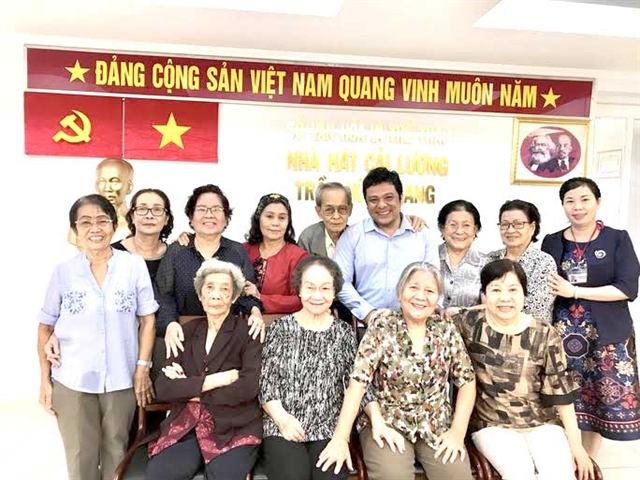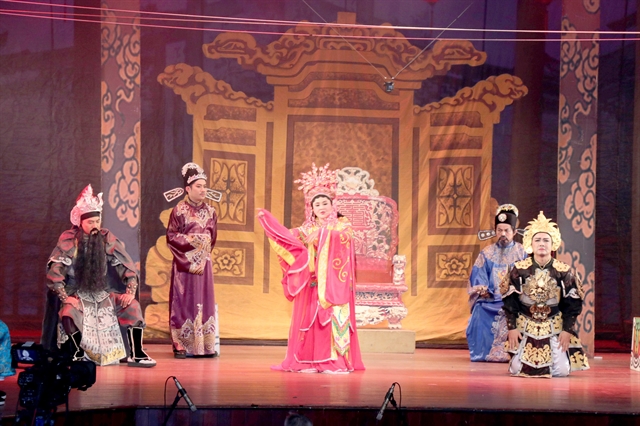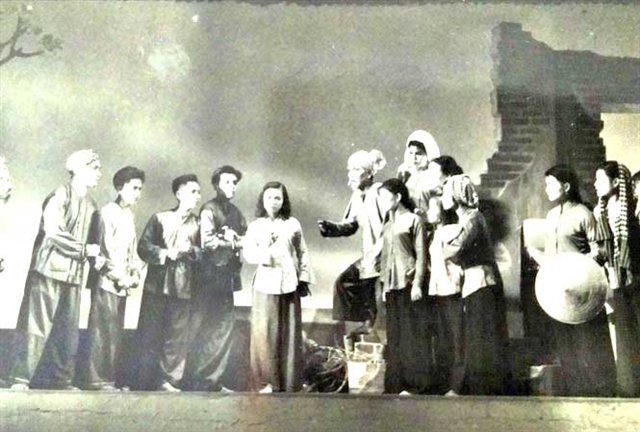 Features
Features

HCM City’s Trần Hữu Trang Cải Lương Theatre, one of the region’s leading traditional art troupes, will open its exhibit hall featuring information and images about cải lương (reformed opera) to celebrate the 75th anniversary of the August Revolution (August 19, 1945) and National Day (September 2, 1945).

|
| Young artists of Trần Hữu Trang Cải Lương Theatre follow in the older generations’ footsteps by helping to preserve cải lương. VNA/VNS Photo by Gia Thuận |
HCM City’s Trần Hữu Trang Cải Lương Theatre, one of the region’s leading traditional art troupes, will open an exhibit hall featuring information and images about cải lương (reformed opera) to celebrate the 75th anniversary of the August Revolution (August 19, 1945) and National Day (September 2, 1945). The hall will also honour veteran artists who used their art to serve the revolutionary movement in South Việt Nam in the 1940s and 50s.
By Thu Mai
A new theatre hall will display photos, books, documents and videos featuring the history and development of cải lương, a traditional genre of southern theatre which began in the early 1920s in the Mekong River Delta region.
Images of Cải Lương Nam Bộ Troupe, which opened in 1952 and attracted artists engaged in the revolutionary movement in South Việt Nam, will be highlighted.
“Our hall aims to honour cải lương and its veteran artists who used their art to encourage southern people and soldiers during the country’s two wars of resistance and national construction,” said Phan Quốc Kiệt, director of Trần Hữu Trang Cải Lương Theatre.
“Through the images and objects, we hope visitors, particularly young people, learn more about the nation’s heroic history and the great contributions that southern artists made to the country and people,” he added.
Cải Lương Nam Bộ Troupe was formed from three cải lương troupes in the region. The troupe sent its artists to perform at the National Music and Theatre Festival in Hà Nội in 1955 after the 1954 Geneva Agreement on Indochina was signed.
The troupe played a very important role in the theatre’s developments in the South. Its artists used their art to encourage southern people, intellectuals, poor farmers, and workers to join the national revolutionary movement. Their plays, such as Lửa Cháy Lên Rồi (The Fire) and Máu Thắm Đồng Nọc Nạn (Blood in the Nọc Nạn Field), portrayed patriotism and Vietnamese culture and characters.

|
| Veteran artists of Cải Lương Nam Bộ Troupe, who used their art to serve the revolutionary movement in South Việt Nam in the 1940s and 1950s. They still work to keep their art alive and show it to younger artists. Photo by Thanh Hiệp |
“We travelled around the region to offer shows featuring the activities of the Việt Minh (Việt Nam League for Independence) Committee of the South in August 1945,” said Thiện, who worked for the troupe from 1953 to 1956.
Thiện and his colleagues, such as Meritorious Artist Ca Lê Hồng and Trần Hoàng Khanh, still work to keep their art alive and show it to younger artists. They have worked with Trần Hữu Trang Cải Lương Theatre to offer training to young artists.

|
| Images and objects featuring cải lương (reformed opera) and its artists will be on display at a new exhibit hall at Trần Hữu Trang Cải Lương Theatre in HCM City, one of the region’s leading traditional art troupes. The hall is expected to open on National Day, September 2. VNA/VNS Photo by Gia Thuận |
Revolutionaries
The exhibit hall will display and honour Trần Hữu Trang and Nguyễn Phương Danh, both revolutionaries and recognised as the foremost cải lương artists.
Playwright Trang was born in 1906 to a farmer family in Chợ Gạo District of Mỹ Tho Province (now Tiền Giang Province). He began his professional career in 1928, working for leading troupes owned by Trần Đắc, Năm Phỉ and Năm Châu, respected veterans of cải lương.
In the 1930s, Trang was at the peak of his artistry and fame, with serious plays such as Lan Và Điệp ( Love Story of Lan and Điệp), Tìm Hạnh Phúc (Seeking Happiness) Đời Cô Lựu (Lựu’s Life) and Tô Ánh Nguyệt (Miss Tô Ánh Nguyệt), which highlight Vietnamese women, their challenges and suffering under feudal society.
After the August 1945 Revolution, Trang joined the revolutionary cause and worked in Sài Gòn-Chợ Lớn. He was a member of the National Front for the Liberation of the South. He died in 1966 in battle. His body has never been found.
Trang was the first to feature women as leading characters in cải lương. He created more than 30 plays which all feature Vietnamese patriotism and characteristics. They have been staged many times by different generations at home and abroad.
For his contributions, he was awarded the Hồ Chí Minh Prize by the Government in 1996.
“Though Trang has passed away, his art is still alive among Vietnamese audiences, particularly southerners,” said Kiệt, director of Trần Hữu Trang Cải Lương Theatre, a leading theatre named after the artist.

|
| Cải Lương Nam Bộ Troupe offered shows encouraging southern people, intellectuals, poor farmers and workers, to participate in the national revolutionary movement. Their plays, such as Lửa Cháy Lên Rồi (The Fire) and Máu Thắm Đồng Nọc Nạn (Blood in the Nọc Nạn Field), portrayed patriotism and Vietnamese culture and characters. Photo courtesy of Trần Hữu Trang Cải Lương Theatre |
People’s Artist Danh joined the August 19 Revolution in An Giang Province’s Mỹ Khánh Commune, following the movement in August 25, 1945 in Sài Gòn.
He was one of the first leaders of the Cải Lương Nam Bộ Troupe. He was chosen to represent southern artists to meet President Hồ Chí Minh in Hà Nội after the 1954 Geneva Peace Agreement on Indochina.
He directed and performed in many cải lương plays for leading troupes and theatres, such as Kim Phụng Cải Lương Theatre and Chuông Vàng Theatre of Hà Nội, Hoa Mai Troupe of Hà Tây Province and Hòn Gai Troupe of Quảng Ninh. Many of his works won top prizes at national festivals and contests.
Danh was the first who used ballet and Vietnamese dances in cải lương. He was also involved in training artists and released several books on Vietnamese theatre, music and dance.
He died in 1976 in HCM City when he was 76 years old.
“Danh is a revolutionary and a talented artist who devoted his life to the country and traditional theatre,” said Thiện, one of Danh’s students.
The theatre’s exhibit hall will open on National Day, September 2, at 515 Trần Hưng Đạo Street in District 1. VNS




